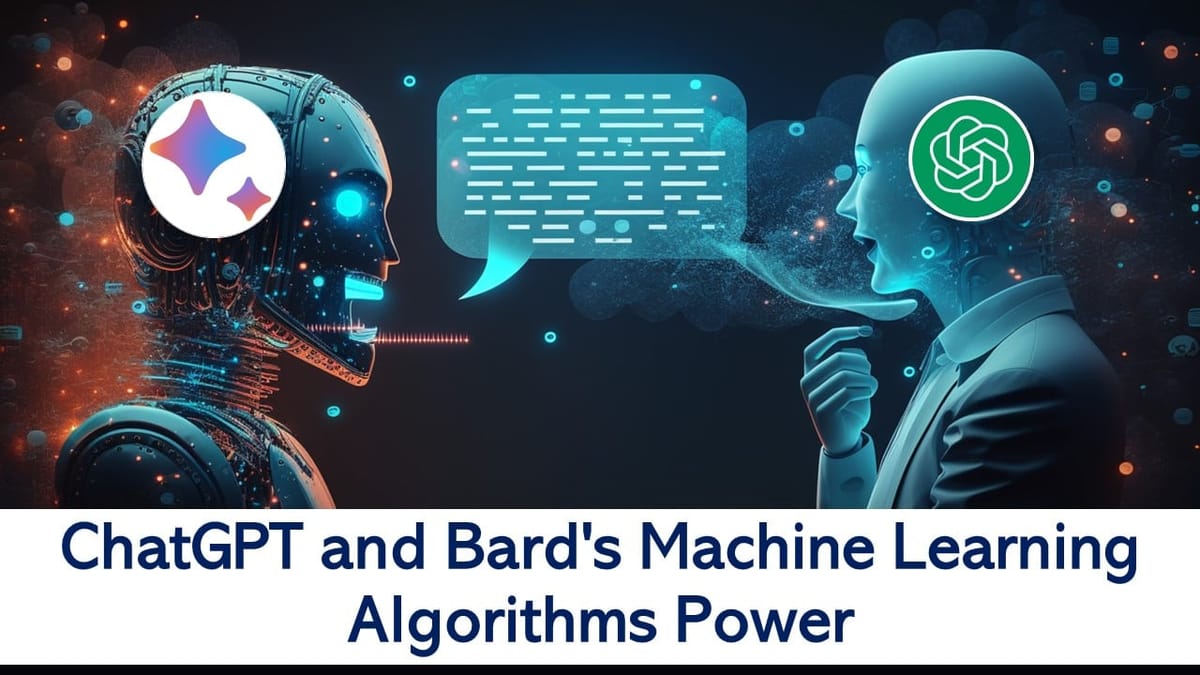Machine learning algorithms are crucial in building sophisticated language models such as ChatGPT and Bard in the dynamic field of artificial intelligence (AI).
Naman Sharma | Jan 8, 2024 |

Exploring ChatGPT and Bard’s Machine Learning Algorithms Power
Machine learning algorithms are crucial in building sophisticated language models such as ChatGPT and Bard in the dynamic field of artificial intelligence (AI). These models, created by OpenAI, show the state-of-the-art in natural language creation and processing. In this piece, we explore the foundations that allow these artificial intelligence wonders to grasp, generate, and interact with ease, delving into the complex world of machine learning algorithms.
Understanding ChatGPT:
ChatGPT is a deep neural network architecture that uses a transformer. It is the replacement for the well-known GPT-3 model. The model’s capacity to process and produce text that resembles that of a person is based primarily on this architecture. ChatGPT can analyze a sentence’s whole context because of the transformer’s self-attention mechanism, which makes it possible to provide more logical and contextually appropriate answers.
Understanding Bard:
Bard has a transformer architecture similar to ChatGPT, but it differs in that it is intended for creative text generation, particularly poetry. Poetry’s subtleties—meter, rhyme, and metaphor—present particular difficulties that demand specific algorithms in order to produce visually beautiful and emotionally impactful poems.
Problems and Restrictions:
Although ChatGPT and Bard exhibit impressive capabilities, their machine learning foundations provide certain restrictions and concerns.
User Interactions and Ethical Considerations:
The ethical implications of ChatGPT and Bard deployment are critical. OpenAI admits that it has an obligation to create a secure and welcoming environment. Ensuring impartial and responsible AI interactions remains a challenge, even with ongoing efforts to match the models with ethical principles.
Machine Learning’s Prospects for Language Models:
Language models like ChatGPT and Bard have bright futures ahead of them as machine learning techniques advance. The goal of ongoing research is to improve the models’ capabilities and get past their present constraints.
Future generations of language models might have multimodal capabilities, which would allow them to process and produce data in addition to text, such as images, audio, and possibly other forms. This would pave the way for more engaging and dynamic AI encounters.
In conclusion:
The machine learning algorithms that form the foundation of ChatGPT and Bard exemplify an intriguing amalgamation of creative expression and natural language comprehension. These models provide a glimpse into the possibility for robots to understand and produce content that resembles that of humans, showcasing the enormous advancements made in AI research.
The trajectory of these language models is being shaped by user feedback, ongoing research, and ethical considerations, despite the persistence of problems and constraints. Finding a balance between scientific breakthroughs and ethical responsibilities is a key subject as we work through the challenges of artificial intelligence. The dynamic interplay that continues to shape the future of artificial intelligence is that of machine learning algorithms and human interaction. The path towards more advanced, responsible, and user-centric language models is being paved by ChatGPT and Bard, offering a future in which AI will be easily incorporated into our daily lives.
The foundation of ChatGPT and Bard is machine learning algorithms, which push the limits of creative expression and natural language comprehension. As we work through the complexities of these algorithms, it becomes clear that ongoing developments in AI research are necessary to improve language models’ capacities, solve problems, and fine-tune the delicate balance between understanding, creativity, and ethical considerations. We are getting closer to machines that can not only understand our language but also connect with our creativity, thanks to the development of AI language models like ChatGPT and Bard.
In case of any Doubt regarding Membership you can mail us at contact@studycafe.in
Join Studycafe's WhatsApp Group or Telegram Channel for Latest Updates on Government Job, Sarkari Naukri, Private Jobs, Income Tax, GST, Companies Act, Judgements and CA, CS, ICWA, and MUCH MORE!"